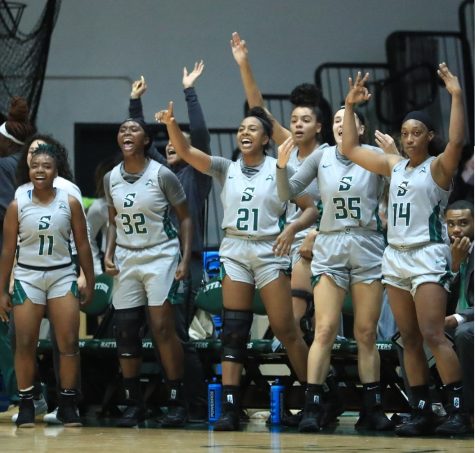The Future is Female
A brief take on the history of female sports at Stetson.

Stetson women’s basketball, shown here in 1906. It’s the oldest female sports team on campus, founded only six years after the men’s team in 1900. Photo courtesy of Stetson Archives.
December 9, 2019
School sports have been an extracurricular at Stetson for over a century. They became popular back in the days when the sociological divide between genders was wider. In other words, there was clear preferential treatment of men over women.
At the same time, the women’s rights movement was in action, which could be why female sports had any chance at all. That being said, women’s sports weren’t always the most important branch of the athletic field.
Women’s sports were seen as inferior to men’s in a world where, most of the time, women themselves were held as just that, inferior. Most women’s teams were overlooked and turned down until fairly recently, especially compared to the history of men’s teams.
At Stetson, the oldest female team is the basketball team. It dates back all the way to 1906, only six years after the men’s team was founded. It’s unclear exactly who founded the team or why it was spurred into action. An interesting fact, though, is that it was established during a year in which men’s basketball was discontinued.
Unfortunately, there’s no real way of knowing whether these events were related or coincidental. Women’s basketball remained the only female team at Stetson until volleyball was founded over seventy years later.
Kaylee Oscarson (‘23), a freshman on the volleyball team, guessed that the team had been established in 1986. “It’s crazy,” she explained when she learned the date had actually been 1980. “Obviously, I was just a little off, but crazy to think the program had such an extensive history.”
It is surprising that volleyball, a female-centric sport, was created as early as it was with no male counterpart to go along with it. But why is that shocking?
We’re ingrained to expect a male sport to outweigh the female counterpart in some way. This most likely comes from the sociological divide between genders. Men have always been seen as stronger and more athletic than women. Take A. Miller, for instance, who wrote an article titled Gender differences in strength and muscle fiber characteristics, on the differences in strength between genders and believed men to be superior. So the idea that a sport came to be without male players to compare them to is surprising, but it shouldn’t be.
“[Female teams are] not viewed as highly as men’s teams… they don’t get advertised as much,” Oscarson continued. Similar to most colleges and universities, football at Stetson is the most advertised sport on and off-campus. Unless they have a personal link to the sport, most students have no idea what’s happening with most female sports.
“I wish I had a better overview of the other teams. I, of course, know mostly about my own team,” Sunniva Helland-Hansen (’20), a senior on the beach volleyball team, said.
This isn’t an uncommon trait to have; most students, on teams or not, don’t seem to know much about sports when they don’t have to. It doesn’t help when the little limelight shed on sports by advertisements goes straight to the men’s teams. “We’re a small school, I don’t feel like people come here to play sports… everyone chooses Stetson because it’s so good with academics.”
The beach volleyball team is one of the youngest at Stetson, having only been in action for eight years. In that time, though, the sport has grown exponentially. Many of the teams have been growing more recently.
According to a freshman on the soccer team, Maggie Struble (‘23), “This year a lot of teams are going through building years,” or years when there are more new players and/or coaches who need to get acclimated to the team.
When asked about when she thought the female soccer team had been established, Struble guessed 1952. This is actually closer to when the men’s team was founded in 1957, but it’s a surprising difference from the actual date being 1993.

“[It’s] surprising that it’s such a large gap compared to the basketball team, maybe there wasn’t enough initiative or there were administrative restrictions,” Struble said.
It shouldn’t be surprising that a player expects her team to have been founded at the same time as other sports, but the unfortunate truth is that it seems to be. The fact is that most people expect female sports to be younger, less successful, and inferior.
The idea that women’s sports need to be put on the back burner to make way for the men is an outdated way of thinking. Our expectations should be reflecting our hope for these teams, which is that they be successful and long-lasting.







